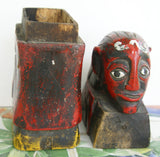ANTIQUE HAND CARVED HAND PAINTED BETEL BOX FROM WEST JAVA REPRESENTING A KELANA MASK & FIGURE, THE DEMON KING RAHWANA FROM THE WAYANG TOPENG & RAMAYANA EPICS. QUID CONTAINER FOR BETEL HABIT
Wonderful old wood betel container (man purse) to add to any Betel habit collection: these items are highly collectible and used in this part of Asia by Shamans for herbs, magic powders, and betel lime habit and by betel nut users etc…. Kelana is the name generally used for the demon king Rahwana in wayang topeng, or Javanese masked dance performances of the wayang stories.
COLLECTED IN JAVA IN THE LATE 1900’S, ESTIMATED TO BE FROM THE MID 1900’S. NEVER FOUND ANYTHING SIMILAR IN LATER YEARS’ SEARCHES.
8 1/4" X 4" X 3"
HAND CARVED AND HAND PAINTED, LONG AGO. VERY UNIQUE RED DEMON KELANA WOODEN PURSE, INTERESTING MOTIF, HAS SOME METAL LOOPS ON THE SIDES TO RUN A CORD THRU AND WEAR AS A PURSE FROM THE SHOULDER, AS USED TO BE THE WAY TO CARRY IT.
LOOK AT PHOTOS CAREFULLY TO BE SATISFIED, CONDITION IS CLEARLY SEEN.
The fruit of the areca palm (Areca catechu) is chewed together with lime and betel pepper as a stimulant by peoples of the East and Papua New Guinea, among other places. Chewing it blackens the teeth and stains the mouth deep red.
Betel is one of the oldest intoxicants and was the most popular until the beginning of this century. Betel is classified as a mild stimulant similar to coffee. It has a multitude of meanings and uses, and the habit of chewing betel is well integrated into the different communities of the Golden Triangle as most of Asia
Kelana is the name generally used for the demon king Rahwana in wayang topeng, or Javanese masked dance performances of the wayang stories. It is likely that the wayang topeng shows rose to wide popularity in the 14th century, which saw the flourishing of the Majapahit Empire, a powerful Hindu state in Central Java. The masks appear in two basic types, personifying noble and evil characters, respectively. Masks of the first category are identified by their highly stylized, refined and elongated features. The archetypal form of the evil characters, or demons, with their goggling eyes, flat thick noses, sometimes long sharp fangs, etc., goes back to the same source. These stylistic conventions were derived from the iconography of the wayang kulit shadow theatre, which fore-dated the appearance of the wayang topeng tradition by several centuries.
In the epic Ramayana, Rahwana is the demon king of the land of Lanka and the main adversary of Rama, his brother Lakshmana, and their ally Hanuman. Rahwana kidnaps Rama's wife Sita, who is eventually found by Hanuman and his monkey army and rescued by Rama.
Wayang topeng dances are performed at harvest festivals and village celebrations. The dances were originally used to collect then disperse negative supernatural powers. Masks are traditionally believed to contain magic, which is transferred to the dancer who wears it. Old masks are particularly valued, as they are believed to have accrued more potent magic, and the dancer who wears it will thus give a more powerful perforrmance. In the first part of the drama, the dancer is unmasked. At a certain point the dancer takes up a mask, places it on the face,.and instantly is transformed into the character of the mask, whether prince, demon, or clown.
Betel consists of three main ingredients. The leaf comes from a creeper called the betel plant. The second ingredient is a nut from areca palm, and the third is lime that is made from ground seashells or artificially manufactured. These ingredients form the betel quid that is chewed. In addition, other items such as tobacco, spices or medicinal plants may be added as desired.
In order to make a betel quid, you need a betel set. This consists of a number of containers for the different ingredients, a cutter or knife to cut up the areca nut and a mortar and pestle to mix the ingredients together. These elements are often carried in lacquer or metal boxes and can be very elaborately decorated.
Betel chewing causes a rapid production of saliva of a strong red color. After many years one’s teeth become black as a result. Red lips and black teeth were previously thought to be a sign of beauty, especially for young women. "Only dogs, ghosts and Europeans had white teeth!"
Betel played an important role in social interaction. A betel set was placed in front of a guest as a gesture of good manners. If the betel set was removed, it meant that the visit should be terminated. In courtship a gift of a betel quid was a sign of affection.
Betel was used extensively in rituals. In exorcism rituals betel was used as a means of transferring magical powers in order to drive out evil spirits. At marriage rituals, the couple was given a betel set for two symbolising unity and fertility. In addition, the ancestral spirits received regular offerings of betel from the living.
Those who chew betel have always claimed that it has positive effects on the body. Western medicine has since verified this. Chewing betel protects teeth from bacteria and aids in digestion. The combination of ingredients in the betel quid actually kills a number of harmful stomach parasites.
Betel was very popular among all ethnic groups in Southeast Asia but is now only use by elderly women. Western ideals about appearances (white teeth) and hygiene (rules against spitting and the spread of diseases) have influenced local attitudes. The use of betel has decreased dramatically over the last 50 years and has been replaced by tobacco.
All our collector and rare items come with pages and pages of research about provenance, and with history of the tribes and photos as well, depending on item and whenever possible. When shipping internationally, we group ship multiple purchases to save you money. If you have any questions or want to see research conducted on this piece and photos of tribes, let us know.









































































